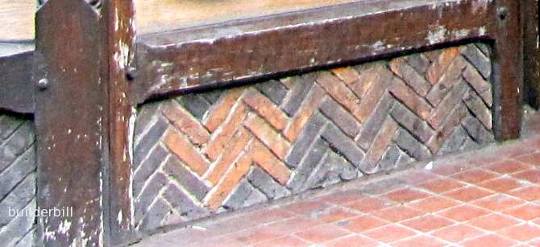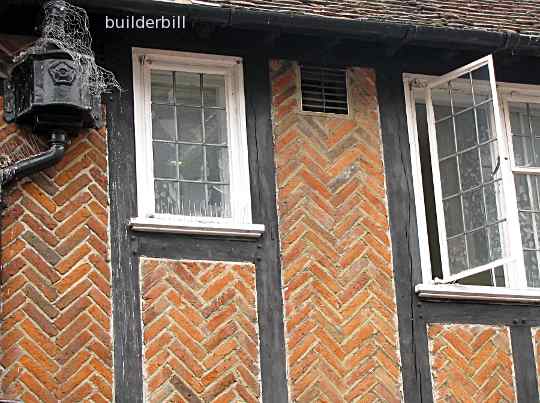 |
|||||
Graphical Construction Glossary >> masonry. >> brickwork >> Herringbone Bond
More often used in paving work where large areas can be done quickly, when used in walls like shown here, there is an awful lot of cutting to be done. This type of decorative work came into fashion during the Tudor era. The buildings were typically made with large timber frames and the brickwork was not structural but in a small extent used to cut down the risk of fire and I guess to show the wealth of the owner. Both of these example are original, the top one being near Lincoln's Inn in London and the one below in the centre of Canterbury near the Cathedral. This half timbered style made it's appearance again with the Mock Tudor of the early twentieth century. Built out of brick with 1" timber fixed to the face, imitation pegs and all. At least it saved the brickies a lot of cutting. :-)
Looking at this photo it is easy to see that this pattern can use any size of bricks, for walls with a 10mm joint, or for paving with no joint. If you didn't find exactly what you are looking for try this
search tool that will search the site and the web. "What can be added to the happiness of a man who is in health, out of debt, and has a clear conscience? "When we build, let us think that we build for ever."John Ruskin 1819-1900 |
Hire Equipment  Furniture Fittings - Architectural Hardware - Electronic Locking Systems - Technical Hardware BuilderBill sponsorship Glossary Pages.Roof Glossary and Roofing Formwork Glossary and other tempory work. Hand Tools Glossary Power Tools Glossary Asbestos Glossary Woodwork Glossary Stair Glossary Concrete Glossary Masonry Glossary doors Glossary BuilderBill Books Building Maths  Stair Design  Asbestos Book |
||||
|
|
|||||
|
Please Note! The information on this site is offered as a guide only! When we are talking about areas where building regulations or safety regulations could exist,the information here could be wrong for your area. It could be out of date! Regulations breed faster than rabbits! You must check your own local conditions. Copyright © Bill Bradley 2007-2012. All rights reserved. |
|||||

